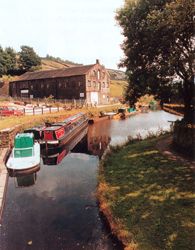|
The Huddersfield
Narrow Canal runs for twenty miles from Portland Basin in Ashton-under-Lyne
through the Pennines to the centre of Huddersfield. It is a waterway of
startling contrasts with stretches of tranquil, well-wooded rural charm
and industrial development - a reminder of the days when it was the shortest
way of carrying goods and people between Lancashire and Yorkshire.
Today
the canal is being fully restored to navigation and will be open again
from April 2001. Meanwhile there are long stretches of the canal to enjoy,
with canal boat trips, many attractions nearby and picturesque circular
walks, both long and short.
|
 |
 |
The canal
was sanctioned by an Act of Parliament in April 1794 but it was not until
1811 that boats were able to cruise the full length of the waterway. This
was mainly because of the cutting of the Standedge Tunnel (see below)
through the Pennines.
A late
arrival at a time when artificial waterways were making possible the Industrial
Revolution, the canal was never a major success. The advent of the railways
brought a much faster method of moving goods and canal traffic diminished
to a trickle. In 1944, by Act of Parliament, the canal was closed to navigation,
abandoned and forgotten.
|
|
The Standedge
Tunnel is the longest, highest, deepest canal tunnel in the UK. It was
originally completed in 1811, seventeen years after the canal works started.
The tunnel, from Diggle to Marsden, is nearly 3 1/4 miles (5.2 km) in
length and was an amazing achievement at a time when sophisticated equipment
had not been developed and unpredictable explosives and human effort were
the means of blasting through the Pennine gritstone.
Since
the closure of the canal the tunnel has fallen into a state of disrepair
with four major rock falls, a year's worth of dredging and much structural
repair is required to reopen it.
|
 |





